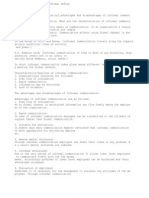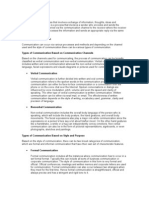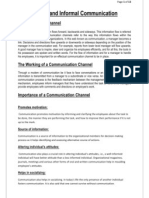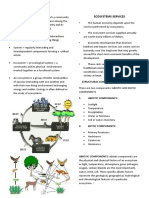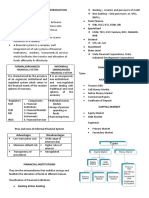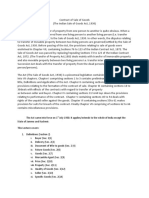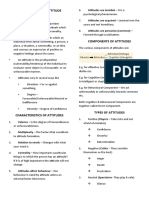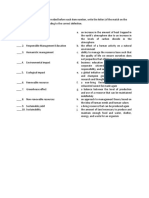0 ratings0% found this document useful (0 votes)
636 viewsCommunication Networks: Formal and Informal: Chain Network
Communication Networks: Formal and Informal: Chain Network
Uploaded by
Ronan FerrerFormal and informal communication networks both have advantages and disadvantages in organizations. Formal networks include chain, wheel, circle, inverted V, and free flow patterns which dictate the official flow of information. The informal "grapevine" is uncontrolled, flexible but can distort messages as rumors spread rapidly. While informal networks allow for faster solutions to problems, they lack accountability and structure compared to formal networks. Both are important for information sharing but also have drawbacks if not properly managed.
Copyright:
© All Rights Reserved
Available Formats
Download as DOCX, PDF, TXT or read online from Scribd
Communication Networks: Formal and Informal: Chain Network
Communication Networks: Formal and Informal: Chain Network
Uploaded by
Ronan Ferrer0 ratings0% found this document useful (0 votes)
636 views3 pagesFormal and informal communication networks both have advantages and disadvantages in organizations. Formal networks include chain, wheel, circle, inverted V, and free flow patterns which dictate the official flow of information. The informal "grapevine" is uncontrolled, flexible but can distort messages as rumors spread rapidly. While informal networks allow for faster solutions to problems, they lack accountability and structure compared to formal networks. Both are important for information sharing but also have drawbacks if not properly managed.
Original Title
COMMUNICATION NETWORKS
Copyright
© © All Rights Reserved
Available Formats
DOCX, PDF, TXT or read online from Scribd
Share this document
Did you find this document useful?
Is this content inappropriate?
Formal and informal communication networks both have advantages and disadvantages in organizations. Formal networks include chain, wheel, circle, inverted V, and free flow patterns which dictate the official flow of information. The informal "grapevine" is uncontrolled, flexible but can distort messages as rumors spread rapidly. While informal networks allow for faster solutions to problems, they lack accountability and structure compared to formal networks. Both are important for information sharing but also have drawbacks if not properly managed.
Copyright:
© All Rights Reserved
Available Formats
Download as DOCX, PDF, TXT or read online from Scribd
Download as docx, pdf, or txt
0 ratings0% found this document useful (0 votes)
636 views3 pagesCommunication Networks: Formal and Informal: Chain Network
Communication Networks: Formal and Informal: Chain Network
Uploaded by
Ronan FerrerFormal and informal communication networks both have advantages and disadvantages in organizations. Formal networks include chain, wheel, circle, inverted V, and free flow patterns which dictate the official flow of information. The informal "grapevine" is uncontrolled, flexible but can distort messages as rumors spread rapidly. While informal networks allow for faster solutions to problems, they lack accountability and structure compared to formal networks. Both are important for information sharing but also have drawbacks if not properly managed.
Copyright:
© All Rights Reserved
Available Formats
Download as DOCX, PDF, TXT or read online from Scribd
Download as docx, pdf, or txt
You are on page 1of 3
COMMUNICATION NETWORKS: FORMAL
AND INFORMAL
Formal Communication Network
CHAIN NETWORK: Under the chain pattern, the
Definition: The Formal Communication Network information flows either up or down the line. Here
shows the pattern of the communication, i.e. the each person gets the information from his
way in which the formal communication is immediate superior and then passes it to their
facilitated. immediate subordinates. Likewise, the chain gets
created, and all members get connected to a single
There are several types of formal communication person, typically the leader. This network is suitable
networks classified on the basis of the degree to when the information to be passed is legally
which they are centralized and decentralized. These correct.
are:
WHEEL NETWORK: This is the most centralized
forms of a communication network wherein all the
information flows from one central person,
typically the leader. The other members have little
or no communication link with each other. Here, CIRCLE NETWORK: The circle network is one of the
the leader deliberately controls the line of decentralized forms of a communication network
communication and make sure that the information wherein the information is shared equally among all
reaches all in the group. the members. Here each person gives and receives
information from two or more persons in the
network. Under this pattern, each member has the
equal chance to participate.
INVERTED “V” COMMUNICATION: The inverted
“V” communication is a formal network wherein
FREE FLOW NETWORK: Under this pattern,
the subordinate is allowed to communicate with his
everyone is connected to each other, and the
immediate superior as well as with the superior’s
information can flow freely from anywhere in the
superior, i.e. the boss of the immediate boss. But,
organization. It is the most decentralized form of
however, the communication between the
formal communication. The distinct feature of this
subordinate and the superior’s superior is limited.
communication pattern is that all the persons in the
Thus, several formal communication networks get group are linked to each other and can freely
created in the organization when people follow a communicate with anyone they want.
proper channel of communication in respect of
their hierarchical positions.
INFORMAL OR GRAPEVINE The grapevine is mainly controlled by the
COMMUNICATION employees themselves. As employees control
the grapevine information, sometimes the
Informal communication system is the opposite information may be accurate and sometimes
system of formal communication. In this system the information may be inaccurate.
the communication is made without following any
predetermined rules of policy. Informal • MORE RELIABLE INFORMATION: Most
communication can play a vital role in the employees perceive and believe that the
operation of the organization’s activities. For grapevine contains more reliable information
example, when employees cannot understand the than the information received from upper
subject matter of the communication, they can
management. What employees may or may not
discuss it with others in an informal situation.
However, information can pass through many realize is that many times the grapevine
individuals and can cover a long distance, both contains false information.
making its origin obscure. • Flexibility: Informal communication is more
Also known as grapevine communication because flexible than formal communication because it
there is no definite channel of communication is free from all type of formalities.
• Oral way of communication: Informal
Definition
communication technique more uses oral way
“Informal communication is the flow of information of communication rather than written
without regard for the formal organizational communication.
structure, hierarchical or reporting relationship.”
• RAPID COMMUNICATION: Informal
How it takes place communication transmits very fast. Especially
miss-inflation or rumour spread rapidly to
The exchange of informal messages usually takes
place on the occasion of community meals, social others in the organization.
occasions, parties, etc. On such occasions,
superiors, for example, can gather such information • DISTORTION OF MEANING: Sometimes the
from their subordinates as may be difficult to get meaning and the subject matter of the
through formal communication. Such information is distorted in this system.
communication includes comments, suggestions,
etc. • INFLUENTIAL: Can have a huge impact on those
Under this, communication takes place through directly involved in the information being
gesticulation, moving of head, smiling and by conveyed.
remaining quiet. For example, a superior wants to
complain against his subordinate to his higher • FREE FROM ACCOUNTABILITY: The exchange of
officer and at the same time he is afraid of giving it
message is free from accountability to the
in writing. This can be conveyed to the higher
officer through informal communication, say during authority or top executives of the organization.
the course of a conversation.
• SPONTANEOUS: Informal communication is the
process of spontaneous exchange of
CHARACTERISTICS information between two or more people of
• UN-OFFICIAL CHANNEL OF COMMUNICATION: different status within the organizational
Since an informal communication network does structure.
not follow any rules or formalities, it is, by
nature, an unofficial channel of communication. • MULTIDIRECTIONAL: Informal communication is
multidirectional in nature. The grapevine may
• NOT CONTROLLED BY MANAGEMENT: The
be largely available to simply serve the interests
grapevine is not controlled by management.
of the people it involves. Many times,
employees use the grapevine to begin rumours • There are many problems which cannot be
that serve their own interests, with little regard solved with the help of formal communication.
for the people they affect. Like a grapevine, it There is more freedom in informal
moves in a zigzag manner. communication which helps the solution of
difficult problems.
POSSIBILITY OF RUMOUR AND DISTORTION:
5. SATISFYING THE SOCIAL NEEDS OF WORKERS:
• Responsibility for the true or false nature of
communication does not lie on any individual • Everybody wants good relations with the high
and, therefore, not much attention is paid to its officers at the place of his work. Such relations
meaning while communicating. Consequently, give satisfaction to the employees and they feel
the rumours keep floating. proud. But this can be possible only with the
help of informal communication.
QUICK RELAY:
• Informal communication makes news spread
like wildfire. Not only this, people start adding LIMITATIONS
something of their own which sometimes
changes the real meaning of the The defects or limitations of the informal
communication. communication are as follows:
ADVANTAGES of Informal Communication 1. UNSYSTEMATIC COMMUNICATION:
The informal channel of communication has • This communication is absolutely
the following advantages: unsystematic and it is not necessary that
information reaches the person concerned.
1. FAST AND EFFECTIVE:
2. UNRELIABLE INFORMATION:
• Under this communication, the messages move
fast and their effect is equally great on the • Most of the information received through
people. this communication is undependable and no
important decision can be taken on its basis.
2. FREE ENVIRONMENT:
• Informal communication is done in a free
environment. Free environment means that
there is no pressure of any office-big or small.
The reactions of the employees can easily be
collected.
3. BETTER HUMAN RELATIONS:
• Informal communication saves the employees
from tension. Freedom from tension helps the
establishment of better human relations. This
also affects formal communication.
4. EASY SOLUTION OF DIFFICULT PROBLEMS:
You might also like
- Functional Language Bank PDFDocument10 pagesFunctional Language Bank PDFTimofej KoniajevNo ratings yet
- Marxist TheoryDocument31 pagesMarxist Theoryllefela2000100% (4)
- Barriers of CommunicationDocument15 pagesBarriers of CommunicationPallavi Kuchewar100% (1)
- Taking Action and CommunicatingDocument10 pagesTaking Action and CommunicatingFikom PraNo ratings yet
- Notes On Effective CommunicationDocument11 pagesNotes On Effective Communicationpoojasambrekar0% (1)
- Fundamentals of Corporate Law - Module 1 IntroductionDocument6 pagesFundamentals of Corporate Law - Module 1 IntroductionRonan FerrerNo ratings yet
- Building Emotional CompetenceDocument2 pagesBuilding Emotional CompetenceRonan Ferrer100% (2)
- Hach Nitrate Method 10206 Final 01102013Document10 pagesHach Nitrate Method 10206 Final 01102013dunavko1No ratings yet
- Communication NetworksDocument5 pagesCommunication NetworkssmrataNo ratings yet
- Informal CommunicationDocument2 pagesInformal Communicationsinghalmayanka1No ratings yet
- Context Based Speaking PDFDocument3 pagesContext Based Speaking PDFAnonymous OU4bgLNo ratings yet
- DecentralizationDocument8 pagesDecentralizationMrito ManobNo ratings yet
- MemoDocument23 pagesMemoParag PhulerNo ratings yet
- Language and Writing (Communication and Its Types)Document12 pagesLanguage and Writing (Communication and Its Types)Devansh Kumar SinghNo ratings yet
- Types of CommunicationDocument13 pagesTypes of CommunicationAKINYEMI ADISA KAMORU50% (2)
- Flow of CommunicationDocument27 pagesFlow of CommunicationSupriya RakshitNo ratings yet
- Memo Vs CircularDocument3 pagesMemo Vs CircularAli ShahzadNo ratings yet
- Types & Methods of CommunicationDocument6 pagesTypes & Methods of CommunicationNicoleNo ratings yet
- Memo - Lecture NotesDocument1 pageMemo - Lecture NotesChinu Cooldude100% (1)
- Personal, Social, Business CommunicationDocument1 pagePersonal, Social, Business Communicationankan2881100% (1)
- Topology and Its TypeDocument4 pagesTopology and Its TypeNEHA CHAHARNo ratings yet
- Attitude - Social PsychologyDocument7 pagesAttitude - Social PsychologyIsha JoshiNo ratings yet
- Cohesion and CoherenceDocument18 pagesCohesion and CoherenceAbdul MoizNo ratings yet
- Schramm Model's of CommunicationDocument7 pagesSchramm Model's of CommunicationRica Mae LunaNo ratings yet
- Introduction To Communication SkillsDocument14 pagesIntroduction To Communication Skillsanna100% (2)
- Elements of PresentationDocument11 pagesElements of PresentationSubham .MNo ratings yet
- Communication Network of An OrganizationDocument47 pagesCommunication Network of An Organizationmeann71100% (11)
- Barriers To Effective CommunicationDocument2 pagesBarriers To Effective CommunicationAnu JaiswalNo ratings yet
- Communication ProcessDocument8 pagesCommunication ProcessMahalakshmi100% (1)
- Case Work .Document24 pagesCase Work .Arya KrishnaNo ratings yet
- Syntax NotesDocument11 pagesSyntax NotesLong Nguyen100% (1)
- RelationshipsDocument5 pagesRelationshipsSatyam Pathak100% (1)
- CMJ 1100 Complete NotesDocument58 pagesCMJ 1100 Complete Noteskorirenock764No ratings yet
- Barriers To Effective CommunicationDocument25 pagesBarriers To Effective CommunicationGlenda VestraNo ratings yet
- Unit Social Welfare Administration: Concept, Nature and ScopeDocument18 pagesUnit Social Welfare Administration: Concept, Nature and Scopebirendra momNo ratings yet
- Communication Is A Process of Transmitting Information From Origin Recipients Where The Information Is Required To Be UnderstoodDocument10 pagesCommunication Is A Process of Transmitting Information From Origin Recipients Where The Information Is Required To Be Understoodal_najmi83No ratings yet
- Business CommunicationDocument13 pagesBusiness CommunicationMd Alimur Razee RealNo ratings yet
- Types of ResearchDocument5 pagesTypes of ResearchAngel PasaholNo ratings yet
- Business CommunicationDocument15 pagesBusiness CommunicationBibin FrancisNo ratings yet
- A Company Is A Legal Entity Formed by A Group of Individuals To Engage in and Operate A BusinessDocument2 pagesA Company Is A Legal Entity Formed by A Group of Individuals To Engage in and Operate A Businessbyrikishore ByriNo ratings yet
- Process of Communication 4Document7 pagesProcess of Communication 4Sat SharmaNo ratings yet
- Computer LanguagesDocument7 pagesComputer LanguagesPoonam Mahesh PurohitNo ratings yet
- Advantages of Horizontal CommunicationDocument3 pagesAdvantages of Horizontal CommunicationMihir Shah100% (1)
- Communication ChannelsDocument12 pagesCommunication ChannelsAshwini Kumar100% (1)
- Models of CommuncationDocument14 pagesModels of CommuncationJoemar YubokmeeNo ratings yet
- Levels of Communication PDFDocument2 pagesLevels of Communication PDFNikhil PrasannaNo ratings yet
- BBI2421 - Assignment 1Document7 pagesBBI2421 - Assignment 1Nik Nur MunirahNo ratings yet
- Communication ProcessDocument42 pagesCommunication ProcessJr RequitaNo ratings yet
- Marxist Literary CriticismDocument2 pagesMarxist Literary CriticismCekgu Inggerih100% (1)
- Two Types of Democracy 1. Direct DemocracyDocument7 pagesTwo Types of Democracy 1. Direct DemocracyRukudzo Rukwata-NdoroNo ratings yet
- Assignment: Topic Communication Subject Advanced Practice NursingDocument12 pagesAssignment: Topic Communication Subject Advanced Practice NursingPawan Batth50% (2)
- Functions of Mass CommunicationDocument2 pagesFunctions of Mass CommunicationwandererAntNo ratings yet
- Measures of DispersionDocument26 pagesMeasures of DispersionAshish Sen GuptaNo ratings yet
- Presentation 5 - Culture and Society PDFDocument18 pagesPresentation 5 - Culture and Society PDFStefania Dimancea100% (1)
- A Communication ModelDocument14 pagesA Communication Modelrace_perezNo ratings yet
- Formal and Informal CommunicationDocument13 pagesFormal and Informal Communicationankit161019893980100% (2)
- Unit-II Presentation SkillsDocument9 pagesUnit-II Presentation SkillsRaghavender ReddyNo ratings yet
- National Cultural VariablesDocument43 pagesNational Cultural VariablesAman Jazil Faruqi50% (2)
- Linguistic Minority Concept in India: Myth and RealityDocument15 pagesLinguistic Minority Concept in India: Myth and RealityAnonymous CwJeBCAXpNo ratings yet
- Criticisms of FunctionalismDocument2 pagesCriticisms of FunctionalismAmber47No ratings yet
- Civilmili PresentDocument9 pagesCivilmili PresentUstazah WrinkleNo ratings yet
- Channels of Communication: Presented ByDocument18 pagesChannels of Communication: Presented BySachin SharmaNo ratings yet
- CSCO 104 Organisational CommunicationDocument39 pagesCSCO 104 Organisational CommunicationTinotenda TagariraNo ratings yet
- 6-Types of CommunicationDocument28 pages6-Types of CommunicationShimaa KashefNo ratings yet
- Indian Contract Act 1872 NewDocument17 pagesIndian Contract Act 1872 NewRonan FerrerNo ratings yet
- HUMAN POPULATION and THE ENVIRONMENTDocument4 pagesHUMAN POPULATION and THE ENVIRONMENTRonan FerrerNo ratings yet
- Ecosystems ServicesDocument9 pagesEcosystems ServicesRonan FerrerNo ratings yet
- Effective CommunicationDocument7 pagesEffective CommunicationRonan FerrerNo ratings yet
- Environmental Studies Global Human Population GrowthDocument5 pagesEnvironmental Studies Global Human Population GrowthRonan FerrerNo ratings yet
- Indian Financial System An IntroductionDocument4 pagesIndian Financial System An IntroductionRonan FerrerNo ratings yet
- Demand and Supply Demand Cross DemandDocument5 pagesDemand and Supply Demand Cross DemandRonan FerrerNo ratings yet
- Essentials of Contract of SaleDocument6 pagesEssentials of Contract of SaleRonan FerrerNo ratings yet
- Elasticity of DemandDocument7 pagesElasticity of DemandRonan FerrerNo ratings yet
- Consumer and Producer SurplusDocument3 pagesConsumer and Producer SurplusRonan FerrerNo ratings yet
- Capital Expenditure VS Revenue ExpenditureDocument5 pagesCapital Expenditure VS Revenue ExpenditureRonan FerrerNo ratings yet
- Contingent Assets and Contingent LiabilitiesDocument5 pagesContingent Assets and Contingent LiabilitiesRonan Ferrer100% (1)
- Nature and Concepts of PlanningDocument8 pagesNature and Concepts of PlanningRonan FerrerNo ratings yet
- COMPETITION LAW and RIGHT TO INFORMATIONDocument6 pagesCOMPETITION LAW and RIGHT TO INFORMATIONRonan FerrerNo ratings yet
- Contract of Sale of GoodsDocument5 pagesContract of Sale of GoodsRonan FerrerNo ratings yet
- Distribution and Marketing Communications MixDocument11 pagesDistribution and Marketing Communications MixRonan FerrerNo ratings yet
- CENTRAL BANK and COMMERCIAL BANKDocument3 pagesCENTRAL BANK and COMMERCIAL BANKRonan FerrerNo ratings yet
- BASIC CONCEPTS OF 5S KAZIEN and TQM APPROACHDocument2 pagesBASIC CONCEPTS OF 5S KAZIEN and TQM APPROACHRonan FerrerNo ratings yet
- Company Law: Kinds of CompaniesDocument14 pagesCompany Law: Kinds of CompaniesRonan FerrerNo ratings yet
- Analyzing Marketing OpportunitiesDocument7 pagesAnalyzing Marketing OpportunitiesRonan FerrerNo ratings yet
- Building Positive AttitudeDocument2 pagesBuilding Positive AttitudeRonan FerrerNo ratings yet
- Entreprenuership - Case Example 1 Double HappinessDocument2 pagesEntreprenuership - Case Example 1 Double HappinessRonan FerrerNo ratings yet
- Name: Grade: 11 Section:: 1. How Much Do You Spend at The School Canteen in A Day?Document2 pagesName: Grade: 11 Section:: 1. How Much Do You Spend at The School Canteen in A Day?Ronan FerrerNo ratings yet
- BESR WorksheetDocument4 pagesBESR WorksheetRonan FerrerNo ratings yet
- Pleural EffusionDocument34 pagesPleural EffusionFazlullah HashmiNo ratings yet
- Isa 53 JPDocument47 pagesIsa 53 JPFPSMNo ratings yet
- Math7 q1 Week 6 EnhancedDocument11 pagesMath7 q1 Week 6 EnhancedADAM CRISOLOGONo ratings yet
- Recognize Potential MarketDocument6 pagesRecognize Potential MarketBen ZerepNo ratings yet
- Command Verbs For AssignmentsDocument2 pagesCommand Verbs For Assignmentsrismatus sabiliyahNo ratings yet
- A Framework For Auditing HRDocument11 pagesA Framework For Auditing HRadedoyin123No ratings yet
- Colorado Preschool Program: 2010 Legislative ReportDocument15 pagesColorado Preschool Program: 2010 Legislative ReportmzalaznickNo ratings yet
- BeaconhandbookDocument30 pagesBeaconhandbookchris husonNo ratings yet
- Lactational Amenorrhea MethodDocument9 pagesLactational Amenorrhea MethodBianca Watanabe - Ratilla100% (1)
- G4 HealthDocument10 pagesG4 HealthrinjoicecasilNo ratings yet
- Dinosaur Who Discovered Hamburgers - Adisan Books - 2021 - Independently Published - Anna's ArchiveDocument44 pagesDinosaur Who Discovered Hamburgers - Adisan Books - 2021 - Independently Published - Anna's ArchiveCecilia DaoNo ratings yet
- Mrs. Namita NimbalkarDocument6 pagesMrs. Namita NimbalkarAnkit RastogiNo ratings yet
- TheNewStack Book3 Automation and Orchestration With Docker and ContainersDocument141 pagesTheNewStack Book3 Automation and Orchestration With Docker and ContainersCristhian Rey100% (3)
- Monthly Income of Newly Hired Computer TechniciansDocument11 pagesMonthly Income of Newly Hired Computer Technicianshayusa8214No ratings yet
- 01 01 Geology Manual PDFDocument62 pages01 01 Geology Manual PDFrodrigoxtremNo ratings yet
- Using Picture Books in The English Language Classroom: "Voices in The Park"Document15 pagesUsing Picture Books in The English Language Classroom: "Voices in The Park"claude331100% (2)
- AndermannDocument4 pagesAndermannButchay LumbabNo ratings yet
- Sue Halpern - A Dog Walks Into A Nursing Home (Extract)Document31 pagesSue Halpern - A Dog Walks Into A Nursing Home (Extract)Allen & UnwinNo ratings yet
- Differentiate Between Operating, Investing, and Financing ActivitiesDocument5 pagesDifferentiate Between Operating, Investing, and Financing ActivitiessanyaNo ratings yet
- 105058Document41 pages105058Joel TeslaNo ratings yet
- Hand Loom PDFDocument18 pagesHand Loom PDFEkta ShaikhNo ratings yet
- 15-Double Yield Model - FLACDocument6 pages15-Double Yield Model - FLACKTMONo ratings yet
- William Shakespeare 2Document22 pagesWilliam Shakespeare 2Laura GompaNo ratings yet
- Group StructureDocument25 pagesGroup StructureSharon Repiedad GungonNo ratings yet
- More Practice Unit 4Document4 pagesMore Practice Unit 4Fatima VazquezNo ratings yet
- Outline of Physical ScienceDocument15 pagesOutline of Physical ScienceASDNo ratings yet
- Amy Schuman Exploring Narrative Interaction in Multi - DestDocument26 pagesAmy Schuman Exploring Narrative Interaction in Multi - DestCamilla FernandesNo ratings yet
- Cover Letter For Patient Transporter JobDocument5 pagesCover Letter For Patient Transporter Jobiuhvgsvcf100% (2)









